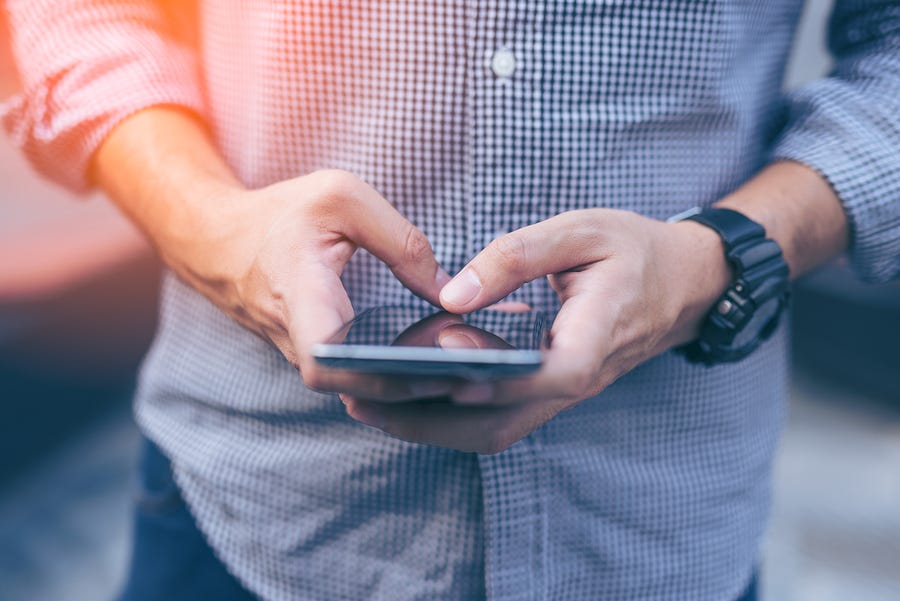2019 mobile app design trends
Continuing education is crucial for mobile app designers. They have to be on top of the latest mobile design trends. Otherwise their work will begin to look outdated, their UI design will be less functional, and eventually, they'll lose jobs to other designers who've done their homework.
But that doesn't have to mean taking new courses every year or spending long hours watching webinars. It can mean keeping up-to-date with your industry's trends and your users' changing needs.
Every year, we take so m e time to reflect on the way mobile design trends have shifted over the past year and make some predictions on the course they'll take in the upcoming year. Here's what we think will be important for mobile app designers to keep in mind for their 2019 designs.
Mobile Design Trends You Should Already Be Incorporating
Full Integration of In-App Gestures
For years now, smartphone designers have been slowly decreasing the number of buttons on our phones until we were left with volume buttons and a power button on the sides, and one, the single home button on the phone's face.

Some early adopters abandoned their home buttons years ago, but more recent releases from Google, Samsung, and Apple have catapulted the clean, edgeless screen into the limelight, forcing mobile app designers to re-think their designs.
The very nature of an utterly buttonless screen changes the way user interface design can be conceptualized, as it forces users toward gestures. Mobile app designers can take advantage of this by adding simple animations based on the gesture necessary to perform a task.
Think about how one might swipe left to delete a message or pull down on a page to refresh it.
By shifting your perspective on UX, you can let your creativity shine through, allowing you to design a UI that's sleeker, more modern, and far more effective. Remember, though — whenever you're introducing a new feature, it's best to show your users how it works, such as through animations or a tour.
Also, losing the home button typically means the screen is getting larger (and in some cases, wrapping around the phone to seem edgeless), which is great for mobile app designers because they get more screen real estate.
We saw this mobile design trend beginning in 2018, but as screens continue to get larger, we can expect this trend to continue — we wouldn't be surprised to see the remaining buttons gone in 2019.
Face ID
One mobile design trend that's helping users ditch the home button is the addition of Face ID.
Because people don't have a button to push anymore, many manufacturers have started using facial recognition to unlock phones, and mobile app designers have started to incorporate this technology into their apps.

This is similar to when smartphone manufacturers added touch ID to their home buttons. We saw many apps — especially those with e-commerce components — allowing users to perform authentication functions by touching the home button. Amazon was an early adopter, allowing customers to use their fingerprint as a way to approve purchases, and of course, smaller apps followed suit.
This is another UI design element that mobile app designers should already be working on, but if you haven't started, now is the time because 2019 is bound to be a year when face ID is more widely used — again, especially in e-commerce apps.
But face ID (or fingerprint ID, for those with older phones) will have the power to take over for simple, but annoying features, like logins — because who can ever remember their password to anything these days?
The best application for face or fingerprint ID is when security can be called into question (such as with logins). This is a good opportunity for you to smooth out your user flow, improve your UI design, and make users feel more secure.
As was the case with physical buttons being replaced with in-app gestures, we only see this trend continuing into 2019.
Mobile Design Trends Emerging in 2019
A Return to Depth
One of the most common mobile design trends in 2018 was the adoption of material design. We discussed it in last year's predictions, specifically pointing out how material design (graciously) returns depth to mobile app design after too many designers turned to flat design.
Now that material design has made its way into the majority of mobile apps, we're beginning to see designs with even more depth — a very welcome change for those of us who enjoy technology with more dimension than a printed piece of paper.

Over the past couple of years, mobile app designers have taken advantage of simple tricks, like subtle drop shadows, animation, and color gradients. While a lot of users adapted easily, others did not — like how people couldn't handle Instagram's logo change a couple of years ago.
But the designers who are using additional elements, like blurred background images, layers, and various degrees of opacity, are creating mobile apps that look polished and clean. One could argue they're far more visually appealing than their flat design-centric counterparts.
We see the return of depth being a mobile design trend that picks up steam in 2019, and we're pretty excited about it.
Augmented Reality
Augmented reality isn't a new mobile design trend. Mobile apps have been incorporating augmented reality for years now — most notably Pokémon Go, which was released in 2016. Pokémon Go took the world by storm, resulting in what appeared to be people wandering around aimlessly looking for rare cartoon figures on their smartphone screens. (One could even argue it's a fitness app.)
But some mobile app designers are using augmented reality to create user interfaces that are functional, practical, and helpful, such as games to teach kids about building with blocks and the physics necessary to knock them down, or figuratively trying furniture out before you buy it. And with Apple's release of ARKit 2, it's likely we'll see more mobile apps weaving in augmented reality in 2019.
Users can pinpoint unnecessary features quickly, typically because the UI design is clumsy or difficult to navigate. As with any other hot mobile design trend, it should only be incorporated when it makes sense to do so.
For example, if your mobile app lets people shop for designer clothes from multiple labels all in one place, using AR to help them try on the clothes to see how they'd look before ordering is probably a good use of this tool. But adding it to your scheduling app? Probably an unnecessary feature you'll waste a lot of money on — and it might even cost you, users.
Motion: Video and Animations
It's probably not a surprise to hear attention spans are getting shorter. In recent years, the average human attention span has decreased from 12 seconds to just eight. (To provide some context, that's one second shorter than the average attention span of a goldfish.)
For mobile app designers competing with millions of other apps available for download, this means not only catching people's flighty attention spans but keeping them — and for longer than 8 seconds at a time.
Luckily, there's a mobile design trend for that.

Social media has been one of the most common places to find a video as a replacement for written content. We see videos of people making food, rather than a traditional recipe, or a close-up front-facing camera shooting someone doing a makeup tutorial.
Both of these videos are probably compelling enough for those interested in the content, and might very well hold our attention spans for longer than eight seconds (at least until that middle-of-the-video ad starts playing).
For mobile app designers, this could mean improving the UX. Using videos or animation to illustrate how to perform a task or demonstrate new features in an app may allow you to portray important information more easily and effectively.
However, designers will need to be careful not to overload users. Videos must be short and sweet (literally one minute is optimal, but definitely no longer than two) and should be small enough in size (file, not pixel) so they don't slow down app performance.
In many cases, animations will do the trick. They are visually interesting, will catch a user's eye, and can demonstrate most things a video can. You can use arrows and pop-up speech bubbles to convey information. You can show a person's finger tapping their way through an app.
There are plenty of UI design options here, but the best part about animations is that they can be led by the users themselves. By having the user tap "next" or an arrow to move on to the next page of the tutorial, tour, or list, you're allowing the user to go at their own pace (and to that end, you're allowing users to move back a screen if they need to).
All of this points to a better onboarding experience at the beginning of a user's journey, as well as at various points along the way, such as when major updates take place, or new features are rolled out. Of course, this could lead to more loyal, educated users.
Chatbots: Conversational Design
In 2017, Facebook unveiled the ability to use chatbots in their Messenger app. Some mobile app designers have jumped on the bandwagon and are creating bots users can find through Facebook's Chat Extensions feature.
But really, the possibilities here are far bigger than Messenger, making chatbots (or some variation of them) an essential mobile design trend.
Conversational design using artificial intelligence can vastly improve your UX. When people are on a website and need help, they often turn to your "contact us" or "help" page, right? If you already use chatbots on your website, users might actually engage with the pop up to get a faster answer. But when people are using a mobile app, help is sometimes harder to find.
If someone is looking to make a purchase right then and there, needing to wait for a response from a customer service rep might be the thing that makes you lose the sale. It's a barrier. Why make it harder for someone to hand their money to you?
How a chatbot looks in your UI design may vary greatly from how someone else uses it, but if you can figure out how to incorporate this feature effectively, it could change the way your users interact with your mobile app. It could convert visitors into customers — and loyal customers, at that.

What These Mobile Design Trends Have in Common
What you've probably noticed is that these mobile design trends all have one major thing in common: they work toward creating a sleek, fluid, and concise user experience.
Face ID and animations can reduce barriers that cause both minor annoyances and major obstacles. The depth and augmented reality can make your UI design look more professional and compelling (and useful, in many cases). In-app gestures help customers become power users. Chatbots ensure your users can find everything they need.
One of the major goals of every mobile app designer is to create a flow that allows users to easily access the app, find what they're looking for quickly, accomplish whatever task they were there to accomplish, and move on with their day.
So whatever mobile design trends you're looking into for 2019, make sure they're contributing to the overall UX. Perhaps not all the things on this list are essential for your mobile app, but they're all worth looking into so you're not falling behind.
What mobile design trends are you working on for 2019? Let us know by tweeting us @Protoio!
Proto.io lets anyone build mobile app prototypes that feel real. No coding or design skills required. Bring your ideas to life quickly! Sign up for a free 15-day trial of Proto.io today and get started on your next mobile app design.
2019 mobile app design trends
Source: https://protoio.medium.com/6-mobile-design-trends-to-watch-in-2019-8ab68112666e
Posted by: moorekrounist.blogspot.com

0 Response to "2019 mobile app design trends"
Post a Comment